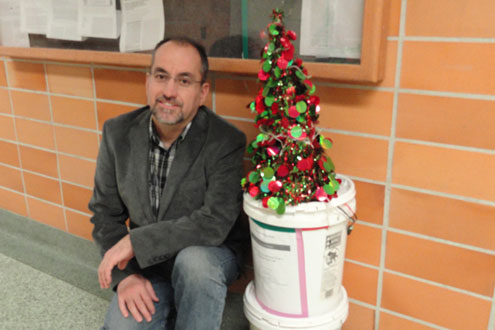Light Up Your Holidays with Microbial Fuel Cell
sue@susanweaver.net
PULLMAN, WA – A small Christmas tree on the Washington State University campus is drawing some extra attention, and it’s not because it’s covered in Cougar paraphernalia.
A professor set up the decoration to draw more interest to chemical engineering.
Now that the semester is over, it’s pretty quiet on the Washington State University Campus. But the Christmas spirit is stirring here in the chemical engineering department.
“Just the lights, attract the people, attract the students. Give them a spark,” said WSU Associate Professor of Chemical Engineering Haluk Beyenal.
This tinsel tree isn’t very large or bright. But its lights are powered by a bucket of dirty water, and it helps Associate Professor Haluk Beyenal teach students about the transfer of electrons.
“When I start to talk about electron transfer, they got bored,” said Beyenal. “So I start with this microbial fuel cells and then talk about this Christmas tree, how it’s lit up.”
So here’s how it works. The microbial fuel cell is in this bucket of dirty water. The wires connect it to a circuit, which powers the lights.”
“Microbial fuel cell, it’s a device which converts chemical energy to electricity,” said Beyenal.
Beyenal said the fuel cells use bacteria in the dirt to constantly create a small amount of electricity, and that electricity can be stored to create a higher voltage less often.
“It depends how much power you want,” said Beyenal. “If you need less power, you can transfer it very often, if you need really high power, you can transfer it every one hour, maybe once in a day.”
He said devices like this could be used to monitor environmental conditions in bodies of water over long periods of time, without the hassle of having to change a battery.
“Everyone talks about global warming,” said Beyenal. “Ya, we are suspicious it is happening, but do we have enough data? In the past, we did not, and now we are developing tools to monitor environment.”
These microbial fuel cells have a long list of real-world applications, but Beyenal said they’re also useful for getting more students on campus interested in science.
“If we train them on new subjects and attract them to a science, it’s a good success,” said Beyenal. “It’s a success for us.”
This is the second year that the microbial fuel cell Christmas tree has been on display in the chemical engineering department, and they say they hope to put up a larger one next year.